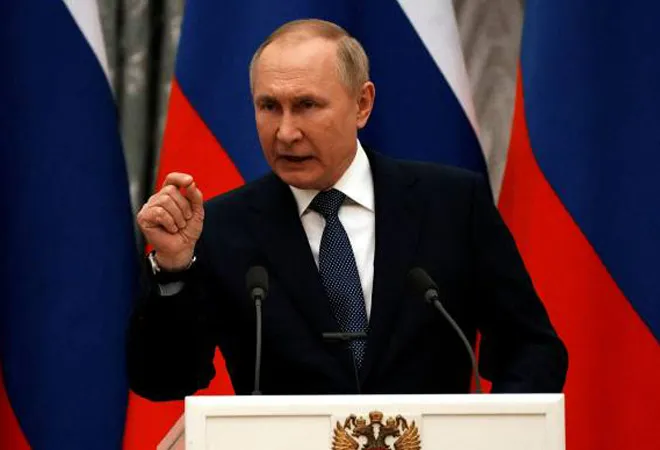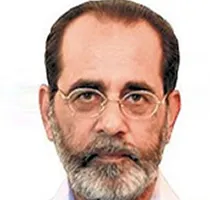2022 has begun on an ominous note with apprehensions of a war breaking out in the heart of Europe. The immediate provocation is the presence of at least 100,000 Russian soldiers engaged in ostensible winter exercises on the border of Ukraine and another 35,000 in Belarus. January witnessed frenetic diplomacy between the leaders of Russia, the United States (US), France, the United Kingdom (UK); meetings of the United Nations (UN) Security Council, North Atlantic Treaty Organisation (NATO), European Union (EU) and the Organisation for the Security and Cooperation in Europe (OSCE); and yet, tensions run high.
What is at stake is not only Ukraine but also the redrawing of Europe’s security map. The first reordering in the 20th century was in 1945, the result of an enormously destructive World War II. The United Nations was created. Respecting territorial boundaries of sovereign states and non-interference in internal affairs became the bedrock for preventing wars in Europe.
However, it was a bipolar world with two hegemons, the US and the then Union of Soviet Socialist Republics (USSR). Europe was divided. The Soviet Union-led military alliance (Warsaw Pact) dominated Eastern Bloc while West Europe came under NATO and US’ extended nuclear umbrella. Germany was bifurcated into an FRG (West) and GDR (East) with NATO-Warsaw Pact dividing line passing through the heart of Berlin.
Convinced that the Western objective is to keep Russia down, President Putin is attempting a third reordering of Europe and Ukraine is the catalyst that has triggered the crisis.
The second reordering of Europe was peaceful and triggered by the coming down of the Berlin Wall in 1989 followed by the unification of Germany, East European and Baltic states coming out the Soviet shadow and finally, the break-up of USSR into Russia and 14 other independent countries in end-1991. The Warsaw Pact was dissolved. However, in Putin’s Russia, there is growing resentment that the second reordering exploited a weakened Russia. Convinced that the Western objective is to keep Russia down, President Putin is attempting a third reordering of Europe and Ukraine is the catalyst that has triggered the crisis. At its heart lies the question: Has the West reneged on its promise not to expand NATO?
In 1989, NATO consisted of 16 countries. After the Berlin Wall came down, US Secretary of State James Baker met Soviet leader Mikhail Gorbachev in February 1990, urging him to let East Germany go. Gorbachev declared that an eastward expansion of NATO was unacceptable. Baker suggested that in return for letting East Germany go, NATO’s military jurisdiction would not be expanded eastwards, an assurance reiterated by West German Chancellor Helmut Kohl the following day.
Months later, on September 12, 1990, the two Germanys and the four occupying powers of Berlin – France, the UK, the USA and the USSR signed the 2+4 agreement that no foreign forces or nuclear weapons would be stationed in Berlin or East Germany. This agreement cleared the way for German unification on October 3 and Germany has adhered to it.
During following months, Poland, Czechoslovakia and Hungary in East Europe, and Lithuania, Latvia and Estonia in the Baltics raised independent flags one after another. By December-1991, even Ukraine and Belarus had exited the Soviet embrace.
Russia became the successor state under President Boris Yeltsin and Gorbachev faded into history. Unable to forget the heavy yoke of the USSR, the newly independent states now wanted the West to guarantee their sovereignty against future Russian interventions.
During early 1990s, US remained conscious of the Baker-Gorbachev understanding. President Bill Clinton famously stated that the US would not draw a new line in Europe. He initiated a Partnership for Peace programme for all former Warsaw Pact countries. Even Russia joined and in 1997, a NATO-Russia Founding Act was signed.
The first warning signs came over a decade ago. At the Munich Security Conference in February 2007, President Putin raised the issue of security guarantees from the US and NATO.
Two years later, flush with victory in the Balkans with NATO now undertaking “out of area operations”, Poland, Hungary and Czech Republic were admitted to NATO, followed by seven more erstwhile Soviet bloc members in 2004 during George Bush years and two each during Obama and Trump periods, taking NATO membership to 30. The cautionary principle that had guided President Bush and his Secretary of State Baker that “the cost of expansion goes up as NATO moves closer to Russia” was forgotten in the intoxicating hubris of the US’ unipolar moment.
The first warning signs came over a decade ago. At the Munich Security Conference in February 2007, President Putin raised the issue of security guarantees from the US and NATO. However, the 2008 NATO Summit Declaration opened the doors for Georgia and Ukraine. Months later, citing Georgian President Mikheil Saakashvili’s actions in South Ossetia as a grave provocation, Russia intervened and took over South Ossetia and Abkhazia.
In 2013, protests against the pro-Russian Ukrainian President Viktor Yanukovich led to the Russian annexation of Crimean Peninsula in 2014; here, Sevastopol hosts the Russian Black Sea naval fleet, providing it access to the Mediterranean Sea and Russian bases at Latakia and Tartus in Syria.
The fact is that Ukraine is not just any other East European nation; it has been part of Russia for over 600 years and last July, Mr. Putin authored an article, “
On the Historical Unity of Russians and Ukrainians”, drawing very clear red lines.
Neither the US nor Russia wants a conflict. Europe is struggling for economic recovery. British Prime Minister Boris Johnson is facing domestic challenges, French President Emmanuel Macron has a difficult re-election in April and German Chancellor Olaf Schulz is yet to make his presence felt. The frenetic diplomacy is proof that all key players are seeking a way out.
Putin has succeeded in focussing Western attention and laid down a set of demands for security guarantees from both the US and NATO. But he has also rejuvenated NATO. A reordering of the European security map is underway; the diplomatic challenge is to achieve it without a destructive war.
This commentary originally appeared in Hindustan Times.
The views expressed above belong to the author(s). ORF research and analyses now available on Telegram! Click here to access our curated content — blogs, longforms and interviews.




 PREV
PREV


